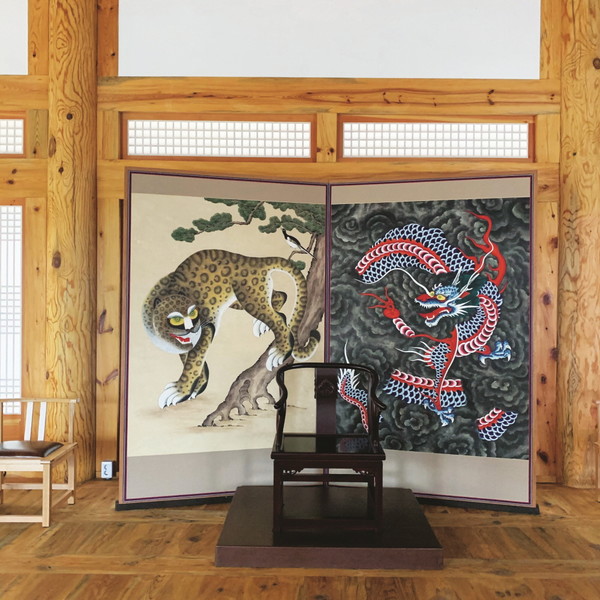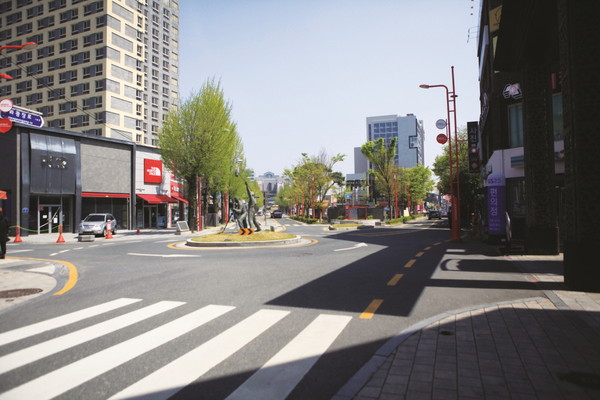Paldal-ro
The name of ‘Paldal-ro’ comes from ‘Paldallmun,’ the east main entrance of Jeollagamyeong. Before the construction of Paldal-ro, there was no main road going through Jeonju. The completion of Paldal-ro brought about the modernization and development of the surrounding commercial area. As a result, Paldal-ro made an enormous contribution toward transforming Jeonju into a modern city. In this issue, we introduce the cultural heritage and modernization of Paldal-ro.

Gyeonggijeon
Gyeonggijeon, which means ‘a happy site where the dynasty began,’ is a place to enshrine the portrait of Lee Sung-gye (the first king of the Joseon Dynasty). If you go straight from the entrance, you can see a building displaying a portrait of King Taejo wearing a gonryongpo(the king’s formal robe). This is the main hall national treasure No. 1578.
On the right side of the building, there is a ‘Jeonju Sago’. This is the only place that protected the Annals of the Joseon Dynasty during the Japanese Invasion of Korea. Although it is not wide inside, you can see the picture of the annals’ editing process.
There is a nice photo spot near the Jeonju Sago. The hanok gate, located between the bamboo forests that grow high on both sides, will make you feel like a member of the royal family.
On the left of the main hall, there are small hanoks. It is a place once used to prepare rituals for King Taejo in Gyeonggijeon. There are also additional spaces such as an old style well, a mill, and a kitchen.

Royal Portrait Museum
On the first floor of the ‘Royal Portrait Museum,’ you can see Korea’s only remaining portrait of King Taejo and other Joseon Dynasty kings. A gama (Korean sedan chair) used to bring King Taejo’s portrait from Seoul to Jeonju is displayed on the first basement floor.
You can download a guide app that introduces the Gyeonggijeon and Royal Portrait Museum in four languages (Korean, Japanese, Chinese, and English).

Jeollagamyeong
Highly recommended: A visit to Jeollagamyeong at sunset because the night view is amazing.
In the Joseon Dynasty, Jeollagamyeong was the provincial office that had jurisdiction over Jeollabuk-do, Jeollanam-do, and Jeju-do. ‘Seonhwadang’ is the private offi ce of the governor. Upon entering, you can see a short video about Jeollagamyeong. 'Gwanpunggak' is where the governor held banquets. There are several telescopes under the building, which show a picture of a governor going around Jeolla-do. ‘Yeonshindang’ is the residence for the governor. In this place, you can experience the history of the Jeollagamyeong through digital books and VR.
Paldal-ro is the way to connect cultural relics with modernization. It is also a standard road for transportation convenience, and a democratic movement took place in Jeonju.

Jeonju Ogeori
Jeonju Ogeori (fi ve-way intersection) connects Jeonju City Hall, Jeonju Pungnammun, Gyeonggijeon, Jeonju Movie Street, and the Jungang Market. Although it also plays a vital role in transportation, it can be s aid that the Ogeori is a place that puts meaning in the formation of culture. There is a place called Ogeori Culture and Arts Square in Ogeori, which is also called the ‘Last For One Square,’ a global B-boy group from Jeonju. If you go in the evening, you can also see people busking. Christmas and New Year's events have also been held at the square.
The ‘Last For One’ is a global B-boy group from Jeonju.

PNB, POONG NYUN Bakery
The PNB is located at the center of the Jungang-dong of Jeonju. It is placed in the center of a prominent intersection in Paldal-ro, the main subject of this article.
PNB is the most famous bakery in Jeonju. It is famous for being a bakery that makes ‘choco pies.’ However, in Jeonju, people's memories are renowned as the bakery where they used to eat ‘jeonbyeong (pancakes)’. Many people love peanut and ginger fl avor. Moreover, there is a record of selling soft ice cream for the fi rst time in Korea. PNB is a historical bakery that has been run by three generations so far. The JBNU Globe recommends that you visit the Paldal-ro where Jeonju's modern history lives.
You can also see a PNB at a department store or online mall.
By Gu Seo-yoon, Kim Ju Myeong Editor

